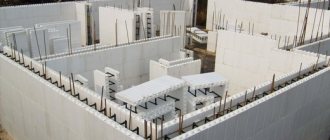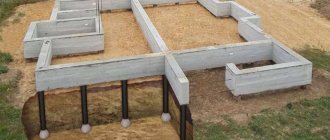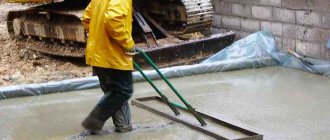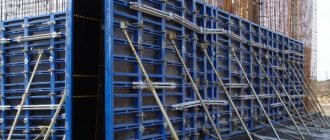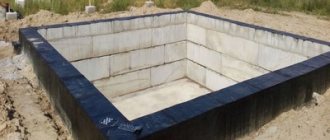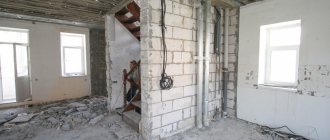The foundation is the basis of any building, so the quality of its installation determines how strong and safe the structure will be and how many years it will last. If mistakes were made during the construction process, or measures were taken poorly to protect the structure from moisture, the situation can be corrected by performing a procedure such as injection waterproofing of the foundation. It is almost impossible to do this on your own, since this requires having some experience, as well as a special installation for pumping the solution into the building.
Foundation injection allows you to create a strong and durable waterproofing layer between the environment and concrete. The essence of the procedure is that low-viscosity material (compositions based on polyurethane or cement) is introduced into the concrete structure, filling all micropores, cracks and defects. As a result, the components crystallize upon contact with moisture and form a durable water barrier.
Strengthening foundations with drilled injection piles
This method has found wide use in Russia and foreign countries in the restoration of historical monuments and residential buildings.
Main advantages:
- can be used on any soil without harming neighboring buildings, which allows use even in dense buildings;
- successfully strengthens not only foundation but also other load-bearing structures (walls, ceilings, vaults);
- uniform distribution of loads on soil foundations;
- high-quality additional waterproofing;
- the possibility of strengthening foundations with vertical drilled injection piles and inclined ones in cramped work conditions.
Bored injection piles are a type of bored piles. Their diameter is 50...300 mm, with a length of ≤ 40 m (for residential buildings a greater length is not required, a depth of 0.5 m below the base is sufficient). Drilling is carried out using mobile core drilling rigs through any structures, further drilling of wells is carried out using rotary drilling rigs. The use of diamond bits significantly increases the drilling speed.
Work order:
- preparation of the site with marking of pile locations;
- drilling a well to the depth of the structure;
- plugging with cement mortar under pressure;
- technological break for three days;
- secondary drilling below the foundation base;
- reinforcement with single rods, welded reinforcement frames, steel profiles or metal pipes with fixation in the center of the well;
- injection of plastic fine-grained concrete mixture under pressure, ensuring a protective concrete layer around the reinforcement of at least 2.5 cm;
- pressure testing by creating excess pressure using a mortar pump.
In soft soils, casing pipes are used.
Vertical piles are mainly located next to the foundation. Then both constructs are combined into a rigid one-piece structure.
More reliable is through reinforcement, passing through the foundation and soil at an angle. Such wells are located with alternating directions - one with an inclination towards the house, the next one away from it. After complete hardening of the mixture, reliable reinforcement is ensured on any soil base. The method is expensive, but extremely effective.
Carrying out work to strengthen foundations is unacceptable without the involvement of specialists. There is a greater risk of getting the opposite result, causing even more damage to the structure.
Thermal method
This method is used mainly for strengthening subsidence soils. The technology for strengthening soil by thermochemical firing is based on treating the base with combustion products of liquid or gaseous fuel. If necessary, the burned material is enriched with additives.
The fuel burns in a sealed well located vertically, horizontally or at an angle. As a result, strong thermal soil pillars are formed.
More modern electrothermal firing is carried out using nichrome electric heaters. The ability to fluctuate the heater power along the well height allows you to adjust the shape and size of the columns formed during firing in accordance with the heterogeneity of the layers.
Strengthening the foundation with screw piles
With the development of new technologies in construction, more technologically advanced methods of strengthening emergency foundations have become available. One of them is strengthening the base with piles.
At this point in time, the technology of using screw piles to strengthen the foundation of a building has become very popular. They are used in areas with heterogeneous soil structure. The uniqueness of the technology lies in the design of the pile itself, namely, the design of the blade, thanks to which it can withstand enormous pressure - up to 25 tons.
It is worth noting that this method is quite expensive, as it requires special equipment. That is why it is usually performed by professional builders.
Work order:
- The first stage in the production of work is carrying out research and calculations. It is necessary to determine the density of the soil along the entire length of the foundation, for which spot soil samples are taken, in which its moisture content and density are determined. If conflicting results are obtained, additional samples are analyzed.
- Based on an examination of the soil and the condition of the foundation, the number of required piles is calculated, as well as their placement locations.
- The issue of taking additional measures to strengthen the foundation is being decided, depending on the degree of its destruction.
- The additional volume of concrete is calculated in the case of concreting piles and the need to install additional stops.
- The second stage in strengthening the foundation with the help of piles is to strengthen the corners of the building with the help of “bulls”. Trenches are dug in the corners of the building to completely expose the foundation. Then it is washed from dirt and allowed to dry for a day.
- After this, a reinforcing belt is constructed at an angle of the building so that the reinforcement bars extend from under the foundation into the trench. On their basis, a reinforcing belt is constructed in the trench itself.
- Then, on two sides of the corner of the building, two or more piles are screwed into the ground to a certain depth, to which reinforcement bars are welded. The result is a monolithic metal structure made of piles and a reinforcing belt.
- Concrete is poured into the pit. Filling is carried out in two stages. In the first stage, concrete is poured to half the height of the original foundation and compacted using a vibrator. After the first layer has dried, you can install formwork smaller than the size of the pit and fill the rest. Thus, it is possible to reduce the consumption of concrete mixture.
- The next step is to strengthen individual sections of the strip foundation. A trench at least 0.5 m wide is dug along the entire perimeter of the base.
- The complete opening of the foundation and its strengthening is carried out gradually; opening the entire wall at the same time is not allowed. To speed up the repair process, work can be carried out simultaneously from different sides of the building.
- The depth of the trench should be equal to the lower level of the foundation. If the work project provides for additional foundation filling, then the trench is deepened, however, the soil under the foundation itself is left untouched.
- If, after opening the foundation, defective areas with broken concrete are discovered, they must be removed. Depending on the location of the collapsed areas, the installation locations of the piles are changed.
- The next step is to screw steel piles into the ground at an angle to the foundation. This is done using special equipment, namely a drilling and crane mechanism, which is installed on a self-propelled unit.
- After completing the installation of piles, a reinforcing structure is installed in the pit and filled with concrete. When the concrete in one area has hardened, you can begin work on the next.
Thanks to this set of measures, the strength of the foundation increases by one and a half times, which makes it possible to complete the construction of the house.
What foundations can be strengthened using drilled injection piles
Types of foundations that are suitable for strengthening using this technology
- Strip concrete and rubble foundations. In such structures, a conical hole is first drilled into which piles and reinforcement are installed. The entire structure is poured under pressure with concrete.
- Pile-grillage and columnar structures. There are several options for using piles. They can be installed under the grillage as additional pillars and part of the load can be transferred to them. You can also replace damaged piles or screws with new ones. The installation principle practically does not change depending on the method of using piles.
- Monolithic foundations. Taking into account the mass of the structure, piles are selected with the maximum possible diameter and length. They also use heavy-duty concrete that can withstand the design load of the entire building. Monolithic foundations using drilled injection piles are strengthened only in extreme cases when other methods are not suitable.
Advantages of using drilled injection piles to strengthen foundations
Compact drilling equipment allows you to work in cramped basement conditions
- Possibility of installation of structures in areas difficult to reach for equipment;
- Foundations are being strengthened in areas subject to strong vibrations;
- It is possible to restore old foundations made of natural stone;
- When designing piles, classical methods of calculating the number and type of structures are used;
- They perfectly withstand the load from a building built on loose soils, because the sole rests on durable layers of soil.
Strengthening the foundation using this method is carried out when:
Example of foundation cracks
- Cracks were discovered in the foundation of the building;
- A local subsidence of a corner of a house or an entire section has occurred;
- If the house is in disrepair, but it needs to be preserved before restoration work begins;
- When you need to protect a damaged foundation or strengthen the foundation from powerful vibrations from railway tracks or highways;
- When it becomes necessary for piles to replace a damaged or destroyed screw or foundation post;
- When buildings in dense urban areas are reinforced with piles.
When is it necessary to use foundation injection?
Let's consider situations when injection waterproofing becomes the most optimal option for protecting the foundation.
- If necessary, repair the leak.
- For waterproofing cracks subject to dynamic loads.
- When repairing cold joints, inject soil under the foundation to strengthen it.
- To create horizontal waterproofing during natural wear and tear of the old moisture protection layer.
- In case of damage to the external walls of recessed rooms (basement or ground floor), violation of the waterproofing of masonry and concrete.
Repair conditions
Installing a screw foundation as an alternative to the existing foundation of a house in use is only possible for frame houses or log houses.
Brickwork does not maintain its integrity under variable bending loads that arise during the production process. In this situation, you can repair the problem area by strengthening reinforced concrete foundations by installing steel screw elements under them, as shown in this photo:
Strengthening against subsidence of MZLF
The versatility of this method is also explained by the fact that SP 24.13330 - 2011 allows not to take into account the effect of heaving forces of the surrounding soil due to the small area of the contact surface of the rack.
Common reasons for partial destruction of building supports are the following:
- Geological. Building on highly mobile soils (swampy, wet soils, peat bogs, highly intumescent, freezing) contributes to the rapid destruction of monolithic, brick/block strip or post foundations.
- Climatic. Large differences in seasonal temperatures, weathering, and wetting have a negative impact on unprotected materials at the surface of the earth.
- Temporary. The deterioration of the characteristics of building materials as a result of aging and wear occurred before the walls and roof reached the same condition.
- Calculated. Significant change in the parameters that were used in calculating the loads on the foundation during the initial construction: weight-bearing reconstruction, additional extension on a common foundation (without sharing the influence).
- Human factor. Violations and errors made during the design, counterfeit and low quality of materials used in construction, deviations from the established technology of work.
Why screw
The main parameters of such a pile
Unlike bored, reinforced concrete or wooden piles, finished screw products enhance the load-bearing capacity without waiting time for shrinkage, significant radial compaction of the soil, or soil vibrations during installation
This is important when carrying out work close to emergency structures, in densely built areas
Comparing the results of calculations of different types of piles for the same section according to SNiP 2.02.03-85, we come to the conclusion that the use of screw structures turns out to be much simpler than other options in terms of determining conditions.
A tangible gain will be obtained in the estimated cost and man-hours of moving the house to new supports.
To make a pile foundation with your own hands, you will need the following tools and materials:
- jacks, set of dies;
- crowbar, shovel, hammer, trowel;
- welding machine;
- tape measure/ruler, building level, chalk;
- screw piles, I-beam, channel.
If the financial side is not decisive, then a special installation for screwing in products, shown in the photo, will help speed up the process:
Effective approach
Strengthening the foundation with piles is possible for the following types of foundations of buildings and structures:
- tape;
- pile;
- columnar;
- slab.
What must be taken into account when using drilled injection piles?
The method has gone through numerous studies. Significant experience has been gained in reconstructing foundations using drilled injection piles. Based on this, experts recommend paying attention to certain features before and during work. This information will simplify your work and avoid serious mistakes.
The angle of inclination of the piles does not greatly affect the amount of settlement and reliability of the structure.
There is no particular need to increase the angle. It is very important to securely secure the piles to the foundation. It is extremely important to strengthen the old foundation, consisting of rubble or individual stones, with cement injections
If the strength of the foundation is too low or the pile is embedded in the foundation by less than 5 diameters, additional reinforcement will have to be made. Preliminary calculations have established that an increase in inclination significantly increases the internal forces in the piles. Much depends on the properties of the soil on which the building is built. If the initial conditions are difficult, it is recommended to use inert materials together with the cementitious mortar. Sand performed well in this role. Along with the use of reinforcement cages, experts recommend that equal-strength joints be included in the project and made. The design can include metal profiles, durable pipes or special glass. The use of reinforcement in various sections and the use of special glass on very weak soils works especially well. The length of the piles depends on the distance to the dense soil layer. The diameter is calculated depending on the conditions, the condition of the foundation and the materials from which it is made. A special point arises when the reinforcing structure passes through groundwater. When passing through a layer of water, concrete cannot set normally and retain its functional characteristics. In this case, the problem can be eliminated by using bored piles. After drilling holes in the foundation, install pipes in them, which will become a kind of formwork.
For the injection method, cement mortar can be ordered. Although experienced craftsmen recommend mixing the solution yourself. This will help reduce work costs. But this is not the main thing. By stirring the solution, you can make sure that the crushed stone in it is fine and control the required density. This will help avoid the formation of voids, which greatly reduce the reliability of the structure.
Types of solutions for waterproofing
Depending on whether injection of the base or walls is required, a solution with optimal technical characteristics is selected.
The most common ways to ensure a building is insulated from moisture are by treating it with liquid rubber or liquid glass. Rubber is elastic, light and flexible. You don't need any construction skills to use it. An even layer is created with minimal training. Rubber is environmentally friendly, so there is no need to worry about the health of residents in the building.
Liquid glass, which contains potassium and sodium silicate, provides multifaceted protection. It will protect against the effects of low temperatures, salt rays, changes associated with wind and corrosion. It is also easy to use, but you need to correctly observe the volume of water and composition.
Processing doesn't work forever. Typically the validity period is no more than five years. It is necessary to repeat the procedure, if possible using an identical solution.
Principle of technology
For drilling-injection supports, wells with a diameter of up to 40 cm are made in the ground. When the required depth is reached, they are filled with water-cement or cement-sand composition, fed inward under high pressure using a hollow auger. By supplying the solution under pressure, it can be poured into both horizontal and vertical wells. Then a reinforced frame base is installed in the not yet hardened concrete.
Reinforcement and concreting requirements
Taking into account the current SNiP, there are certain requirements for concreting and the use of reinforcement in drilled piles. Installation technology:
- The cross-section of the installed frame should always be 14 cm smaller, in contrast to the diameter of the drilled cavity. This allows you to avoid jamming of the frame in the well.
- For reinforcement, spatial frames are used, in which the longitudinal belts are at the same distance in relation to each other. The minimum number of longitudinal rods is 6 pieces, reinforcement class is A3 (section is at least 18 mm).
- Reinforcing frames are subject to high rigidity requirements. The elements are fastened by welding; the reinforcement must be additionally reinforced with steel rings located on the outer part of the frame at a distance of 2 m. Rings with a width of 5-10 cm and a thickness of 8-10 mm are installed.
- The longest length of the reinforcement is 11.7 m. If it is necessary to install the frame in a larger well, then the individual parts are welded to each other on the construction site.
- For the installation of drilled injection piles, M300 concrete with a compression class of at least B22.5 is used.
It is also necessary to pour a protective concrete layer around the frame with a layer of at least 7 cm. Uniform placement of the reinforcement in the well is achieved by attaching the clamps to metal stiffening rings.
Installation conditions
There are also requirements for the LSI installation process itself. Taking into account SNiP, the following conditions must be met:
- During continuous work, you can drill nearby wells in increments that do not exceed 3 diameters of the existing pile. If the distance is less than the permissible one, a new support can be developed only after 24 hours after the previous support has been poured with concrete.
- The process of pouring concrete is carried out with constant forward-return movements of the auger.
- It is necessary to maintain a constant supply pressure of the concrete solution when filling the cavity; when it decreases, it is necessary to reduce the time of extraction of the auger column.
- After the process of pouring concrete is completed, the MDR must move away from the well. The soil that was excavated during the installation of the support is removed using an excavator.
- After cleaning the area, a conductor is installed at the wellhead and the above-ground part of the support column is poured with concrete.
- Reinforcement of the pile is carried out immediately after filling the cavity with concrete and cleaning the wellhead.
Strengthening the foundation with bored piles
Bored piles consist of drilled holes into which reinforcement cages are placed and concreting is carried out with thorough compaction using deep vibrators. Drilling is performed with special equipment or manually using hand or motorized drills. Piles work as stand-up piles, resting on strong solid rock, or as hanging piles, working due to the frictional forces of the side surfaces with the contacting soils. The immersion depth in all cases is ≥ the seasonal freezing mark.
Scope of work for strengthening columnar foundations:
- development of a trench along the perimeter of the foundation structure to a depth of ≥ 0.5 m;
- drilling in unstable soil rocks or to great depths is carried out in casing pipes;
- production of reinforcement frames. Longitudinal rods from periodic reinforcement A-II or A-III with diameters from 12 to 22 mm. Transverse reinforcement is performed with smooth wire rod with a cross-section of 6...10 mm. The placement step is 20...30 cm. Connecting elements of thin knitting wire, softened by firing, using reinforcing hooks or wire cutters;
- installation of the frame. To provide a protective layer of ≥ 2.5 cm, plastic clamps or rectangular cement “crackers” are attached to the frame, and a 10 cm layer of lean concrete is preliminarily laid in the well. If the well is without casing, for additional insulation it is recommended to protect it with 2 layers of roofing material twisted into a cylinder. Longitudinal rods must be released from the well to enter the grillage to 2/3 of its thickness;
- laying the concrete mixture, if there is water, it must be pumped out. Concrete compaction;
- drilling holes in an existing structure, laying pieces of reinforcement into them and fixing them with cement mortar;
- installation of a compacted sand 20 cm cushion;
- installation of formwork and reinforcement frame of a monolithic grillage, with joining to reinforcement outlets of piles;
- laying and vibration compaction of concrete.
Strengthening the strip foundation with piles is carried out in a similar way. A trench along the perimeter of the belt is developed at the level of its sole from the outside, and, if possible, from the inside, which will significantly increase the support area. To prevent the strip structure from moving, it is fixed with side stops made of wooden logs resting against the walls of the trench.
Visible defects in the existing foundation must first be eliminated: jointing and sealing cracks, repairing damaged areas.
If there are difficulties with pumping water, laying a plastic concrete mixture using the vertical lifting pipe (VLT) method is used. The VPT consists of concrete pipe links and a receiving hopper. The hopper mixture flows out of the hopper through the bottom cavity of the pipe and displaces water. After concreting is completed, it is enough to remove the layer of weak concrete (sludge) that has formed at the top. But to lift the VPT, crane equipment will be required.
Instead of bored piles, you can reinforce the foundation with screw piles, consisting of a hollow steel pipe equipped with blades at the end to allow screwing into the ground. Such products have reliable anti-corrosion protection applied in the factory.
The spacing of the pillars, their required diameter and the order of reinforcement and concreting are indicated in the project.
These progressive methods make it possible to increase the load-bearing capacity of the foundation with a minimum amount of excavation work and low labor costs.
In some cases, drilling near an existing structure is impossible due to its severe destruction or extreme dilapidation of the house. The way out is pressed piles. When installing special technical equipment, they are pressed into the ground using powerful jacks. This is a complex and expensive method, so it is used when other amplification options are impossible.
Deep compaction
The soil base is compacted mechanically, using sand or soil-lime piles. When lime is slaked due to contact with water, it increases in volume many times over and presses on the walls of the well, greatly compacting the soil. Other compaction options are the installation of rigid elements or vibratory ramming.
Deep compaction of foundations under already constructed buildings is carried out through inclined wells. Previously, such wells were drilled with drilling equipment, followed by the removal of crushed mass or punched with cores. The imperfection of drilling consists in insufficient compaction, and when punching, a strong dynamic effect occurs and there are difficulties in removing the core from the well.
Now, due to these shortcomings, they are trying to use more advanced technologies for strengthening soils by deep compaction - screw punching or the already mentioned jet cementation.
Features of bored piles
Bored piles are prefabricated holes filled with reinforced concrete. As the concrete hardens in the ground, a reinforced concrete rod with a high load-bearing capacity is formed, which is immersed without pile drivers or other pile-driving equipment. The main advantage of this method is the absence of vibrations during diving. There are no vibration loads on the ground - there is no risk for nearby structures and the landscape as a whole. This is the fundamental difference between bored piles and all others (with the exception of screw piles).
Screw metal piles are driven by screwing, this is also a safe method for landscape use. But their dimensions are limited, which means their load-bearing capacity is also limited (most often, screw piles are used for the construction of private country houses).
It is important!
Bored piles have no load restrictions. The load-bearing capacity values depend on the dimensions of the pile and the calculated resistance of the soil (i.e., on its composition).
Examples (well cross-section - from 10 to 50 cm):
- gravelly and coarse sand - permissible load on piles from 275 to 8831 kg;
- medium-sized sand – from 196 to 6869;
- small, low-moisture – from 157 to 5888;
- fine water-saturated – from 196 to 6869;
- hard clay - 236-11775;
- plastic clay – 79-5888;
- coarse soil, gravel, etc. - 393-11775.
These two features explain the main purpose of bored piles: foundations for residential high-rise buildings, heavy industrial buildings within the city and in areas of dense industrial development.
If you contact us, we will calculate for you the expected loads on your site and help you choose the type of foundation that is suitable in terms of characteristics and cost.
First, about the causes of troubles
It's time to do something
Strengthening the foundation of a private house with your own hands may be necessary if the following facts have occurred:
- Errors in calculations. The foundation of the building is not the component of the building on which you can save. It happens that inaccuracies in determining the optimal strength characteristics are allowed simply due to incompetence. And in other situations, they are a consequence of attempts to minimize the cost of building a foundation. In any case, after a relatively short period of time, the homeowner will have to face an unpleasant surprise.
- Failure to comply with construction technology. The information presented in the next paragraph will be relevant here. Although it is worth adding that deviation from the rules can be provoked not only by the desire to reduce financial costs, but also by an attempt to save time. Neither one nor the other can serve as an excuse.
- Changes in the landscape that occurred after the construction of the building - heaving, rising groundwater levels, excessive saturation of the soil with moisture, etc.
- Large-scale excavation work carried out in close proximity to the structure. This could be, for example, high-rise construction, laying main communications, etc.
- Redevelopment of a building with increased load on supporting structures.
- Vibration loads – internal and external.
What are the signs that indicate that strengthening is required?
The need to carry out such work may arise when the following circumstances are present:
- The ground around the foundation subsided. This result could have been caused by errors in load calculations, increasing floors, and even the construction of multi-story buildings nearby;
- The adjacent soil has eroded. It is necessary to stop the erosion process. To do this, a cement mixture is injected into the soil, and piles are driven or pressed;
- The integrity of the foundation, ceilings, walls, and other concrete structures has been damaged. This becomes noticeable by the appearance of gaps, cracks on the surface, and sagging of the slabs. Such consequences can cause vibrations, mechanical damage, shifts caused by seismic activity;
- The waterproofing layer is damaged. The cause is usually the penetration of groundwater into microscopic cracks in the concrete and into the joints between base slabs. The destruction process is accelerated by the seepage of aggressive media caused by soil movement.
How can piles help?
If you find the problem described above, then solve it immediately. And your best assistant in this matter will be bored, screw, driven or drilled injection piles to strengthen foundations.
After all, any pile is, first of all, a rod that absorbs unnecessary deformation of the foundation structure.
Therefore, using any pile you can eliminate the following foundation problems:
- Sagging or swelling of the base body - simply add piles in the center or along the edges and the destructive moment of forces will be balanced by the forces in the new supports.
- Base roll - strengthen one corner or one side with new supports and the deformation is leveled out by the counterforce.
- Skewed structure - strengthen the sliding part of the foundation with additional supports and your home will be saved.
In addition, with the help of piles you can simply increase the load-bearing capacity of the old foundation. In addition, piles are used in the construction of temporary foundations that hold the structure during restoration or lifting of the old foundation.
Method of injection with concrete mixtures
The use of injection technology is advisable in cases where:
- minor (local) cracks, voids and pores in the foundation structure,
- a slight increase in the massiveness of the object (relative to its original weight),
- normal wear and tear of the foundation during its service life,
- increasing the “fluidity” of the surrounding soil.
The essence of injection technology is to drill holes (holes) of small diameter in the foundation structure and fill them under high pressure with a cement-containing solution of a special composition using injectors. The distance between the holes is 50÷100cm, and their depth reaches half the thickness of the foundation (these parameters depend on the degree of damage).
As a result, all voids in the foundation are filled with this solution and the adjacent layers of soil are impregnated with it. After the solution has cured, the damaged parts of the foundation again form a solid structure, and the soil around it is monolithic, providing an increase in bearing capacity.
Strengthening old foundations
Strengthening the foundation with drilled injection piles is possible for any type of foundation:
- holes are drilled in the tapes (ruble and concrete) at an angle of at least 30 degrees. The depth of drilling depends on how deep the hard soils are. At each hardening point, two wells are made - on the sides opposite to the tape. The prepared cavities are filled with mortar and reinforcement;
- in pile-grillage foundations, reinforcement with drilled injection piles can be done in two ways: complete replacement of damaged piles or installation of additional supports by injection.
Strengthening the foundation of a private house with drilled injection piles is associated with certain difficulties.
Firstly, it is impossible to do without professional heavy equipment when performing this work. And secondly, without engineering calculations it is difficult to select the parameters of the pile.
It is these conditions that are the reason for the high cost of this method of strengthening the foundation. But if you still decide to do this, it is unwise to skimp on the help of professionals.
Read about other foundation repair methods in the following articles:
- about repairing the foundation with screw piles;
- about repairing the foundation of a brick private house with your own hands;
- repairing the foundation of an old wooden house with your own hands;
- about repairing the foundation of a country house with your own hands;
- how to strengthen the foundation with a reinforced concrete jacket;
- technology for replacing the foundation with screw piles.
Video about the technology of installing drilled injection piles.
Traditional methods of strengthening foundations and their disadvantages
In addition to the new techniques described, there are also traditional methods of strengthening foundation structures, the most common of which are:
- increasing the horizontal sectional area of the foundation (achieved by widening it),
- increasing foundation depth,
- installation of additional supports that redistribute loads,
- construction of a reinforced concrete belt around the perimeter of the foundation.
All of them differ from modern technologies in complexity, labor intensity and significant financial costs for implementation.
Protection of the foundation from weathering
If the base is made of brickwork, which does not have high moisture resistance and strength, chemical or physical weathering of the materials may occur. To restore the damaged surface, a plaster metal mesh is used. It uses cement mortar, which is used to plaster the surface.
As you can see, there are many ways to restore the load-bearing capacity of a structure, protect it from destruction, and also strengthen it in the event of an expected additional load, for example, the construction of a second floor.
SOIL INJECTION. SYSTEM MATERIALS:
Materials for soil cementation
Resmix IMZ-B
Resmix IMZ-C
Resmix ZL-F
Resmix ZL-FR
Resmix FR
Materials for soil resinization
Resmix AG-N
Resmix P1U
Resmix P2U
Plasticizing accelerator
Resmix FR
Cementation
Cementation
Strengthening foundations with cementation involves introducing injections of special cement mortars into the base body. What exactly this composition should be depends on the materials used in the construction of the existing foundation. Most often we are talking about classic cement mortar, sand-cement mixture or bentonite. First, holes are made in the base with a drill, into which the solution is supplied under pressure. Using special formulas and data, the optimal number of injections for the damaged area of the foundation is calculated. Upon completion of all manipulations, the concrete base is strengthened and becomes monolithic. This technology is also known as strengthening foundations by injection.
Scheme of work on strengthening foundations using this method
Scheme of strengthening the foundation with drilled injection piles
- A preliminary calculation of the future structure is carried out, a design is prepared;
- The type of soil, its layering and the depth of strong soil layers are determined;
- In clearly designated areas, wells are drilled to a calculated depth at an angle of at least 30 degrees from the vertical;
- A cement-sand mortar is produced with the expectation of obtaining concrete of medium density and low dispersion;
- Using powerful pumps or pneumatic equipment under pressure, concrete is pumped into the wells;
- Ready-filled wells are reinforced with each other and connected to an existing foundation, which is strengthened;
- At the final stage of repair work, the already dried structures are pressed.


